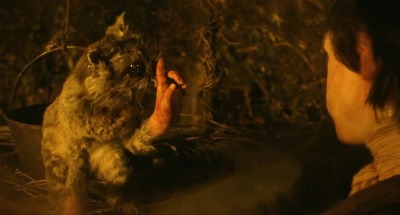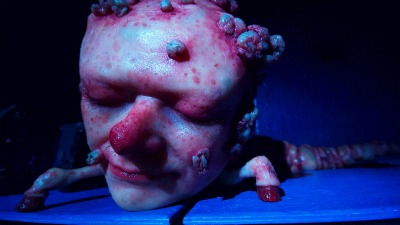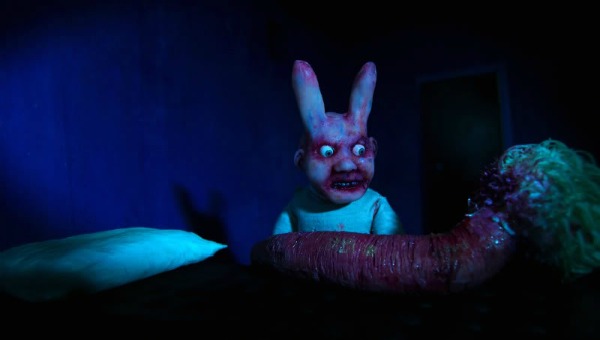With BOBBY YEAH, a BAFTA Short Animation nominee, Robert Morgan engages compulsively with the “poesy en masse”, reaching back across the aeons to draw on myriad atavistic symbols. Just as Francis Bacon fractured his work into separate panels, confounding any imposition of binding narrative, BOBBY YEAH unfurls organically and inexorably in an act of artistic auto-trepanation, encouraging a visceral and deeply empathetic response in the viewer.
httpvh://www.youtube.com/watch?v=jaS_S5Gt7L0
Morgan’s body of work has a heavy psychomachic bent and often draws on childhood fear and compulsion, from the fairytale gothic of THE CAT WITH HANDS to the waking nightmare of MONSTERS. BOBBY YEAH is at heart a simple depiction of ‘satiable curtiosity. There are glimpses of ancient shamanic and hoodoo iconography among the fleshy fetishes of BOBBY YEAH, but each creature toddles, shuffles and crawls about with a toybox spontaneity (Bobby’s very name was conceived in a moment of childish buffoonery) tinged with a growing sense of autonomy and adult responsibility – Bobby’s chubby, ruddy face is fixed in a Groke-like rictus of tooth-grinding anxiety. He has the torso and silhouette of a ragdoll rabbit, but he and his co-stars are fleshed out with silicone and riddled with contusions. They sprout rogue hairs, strange lumps and robust infant willies; many propel themselves on umbilical limbs.
“Bobby Yeah is a petty thug who lightens his miserable existence by brawling and stealing stuff. One day, he steals the favourite pet of some very dangerous individuals, and finds himself in deep trouble. He really should learn, but he just can’t help it.”
This official synopsis is brilliantly mundane, and at first seems at odds with the film it claims to frame – perhaps even a sarcastic response to those who don’t deal in the surreal, and who persistently demand clarification. It might be a light-hearted afterthought, but the fact remains that chicanery, thuggery and Sweeney-style pickles can all be easily recognised among the bizarre imagery. The characterisation in BOBBY YEAH and its predecessors THE SEPARATION and THE MAN IN THE LOWER LEFT-HAND CORNER OF THE PHOTOGRAPH is an anthropomorphic triumph. Relying more on gesture and camera angle than jiggery pokery, each character evinces existential angst with perfect and poignant pity.
… the space is eerie and dreamlike, serving as no more than a lost highway to the next rusty nexus …
The scenery has a weathered, authentic feel, even venturing at one point into the dry grass and sky blue of the real world – but even here the space is eerie and dreamlike, serving as no more than a lost highway to the next rusty nexus, each interior as portentous and uncompromising as any of Bacon’s black triptychs. The sound design is carefully layered – tinkles and creaks against a subtle electronic ambience contextualise the puppets in their strange suburbia.

Morgan cites Poe as an early artistic influence, and Poe’s “The Raven” was written in a similar spirit to BOBBY YEAH: a straightforward narrative, with no pedantry or pretension. With BOBBY YEAH this entails a yielding to the subconscious which marks true adherence to surrealism. The story advances with each discovery of a “Big Red Button”: a cross between a Cold War device and an Infinite Improbability Drive. Each button pressed summons a new breed of playpen cenobite: a Willem Dafoe-faced quasi-scorpion shaped like a Fisherprice Chatter Phone, a screaming Golliwog. The constant respawning and evolution of the beasts calls to mind the life cycle of Pokémon, not least the kidnapped pet which resembles a worm-tailed “Tangela”, its beady eyes peering with mute mystery from a carapace woven from real toenail clippings.
The narrative reaches a climax with the cherubic psychopomp of the second act , who twitters and bats its wings, smug as a pro-lifer’s “unborn angel”, but inevitably fails to suppress the herniating fury of a newborn fetus in fetu which seals Bobby’s fate. By this point he is outnumbered. One tormentor is a bird-headed ithyphallic creature, ominous as either Odin’s or Poe’s ravens but most closely resembling the Palaeolithic birdman painted in the Shaft in Lascaux. Such therianthropic Ice Age icons were said to represent the relationship between man, beast and the heavens.

Rooty and bruised as a forgotten potato, perhaps the most imposing character resembles the centrepiece of a more recent artwork: Salvador Dali’s “Sleep”. Although it could be mistaken for a warty deathmask, the heavy rosacea that blots its swollen lids and Mona Lisa smile establishes this creature as an extension of the dreamland motif: a creeping Endymion, who at one point endures a costume change with all the guileless dignity of a drunk Buckaroo. Only in sleep may we find respite from the burden of society – and even in the land of Nod its legacy confounds us from the left field. The pink, furry walls horripilate as the final act commences, and a wall-mounted sore smirks saucily from its frame like one of Georges Méliès’ moons.
Circumventing spoilers, the motif of the raven has an alchemical resonance which adds to the archetypal flavour of the film. Basil Valentin’s woodcut “Putrefaction” (below) depicts the creation of the Philosopher’s Stone, represented by a raven perched on a decomposing cadaver. The putrefaction which afflicts the cast of BOBBY YEAH reminds us that matter must decompose before True Gold can come into being. Maybe it is a good thing that Bobby done a bad thing.
BOBBY YEAH screens at Bradford Film Festival alongside JUAN OF THE DEAD on Friday 20th and Sunday 22nd April.
Watch Robert Morgan’s earlier films at http://www.robertmorganfilms.com/


What a wonderful and well researched article. This is a tough film to offer any authoritative analysis on, but this illuminates a lot. Thanks!
Thank you! I’m so chuffed that B.Y. came up trumps at the London Sci Fi fest. THE CAT WITH HANDS was brilliant, but B.Y. marks Mr Morgan out as a unique artist.